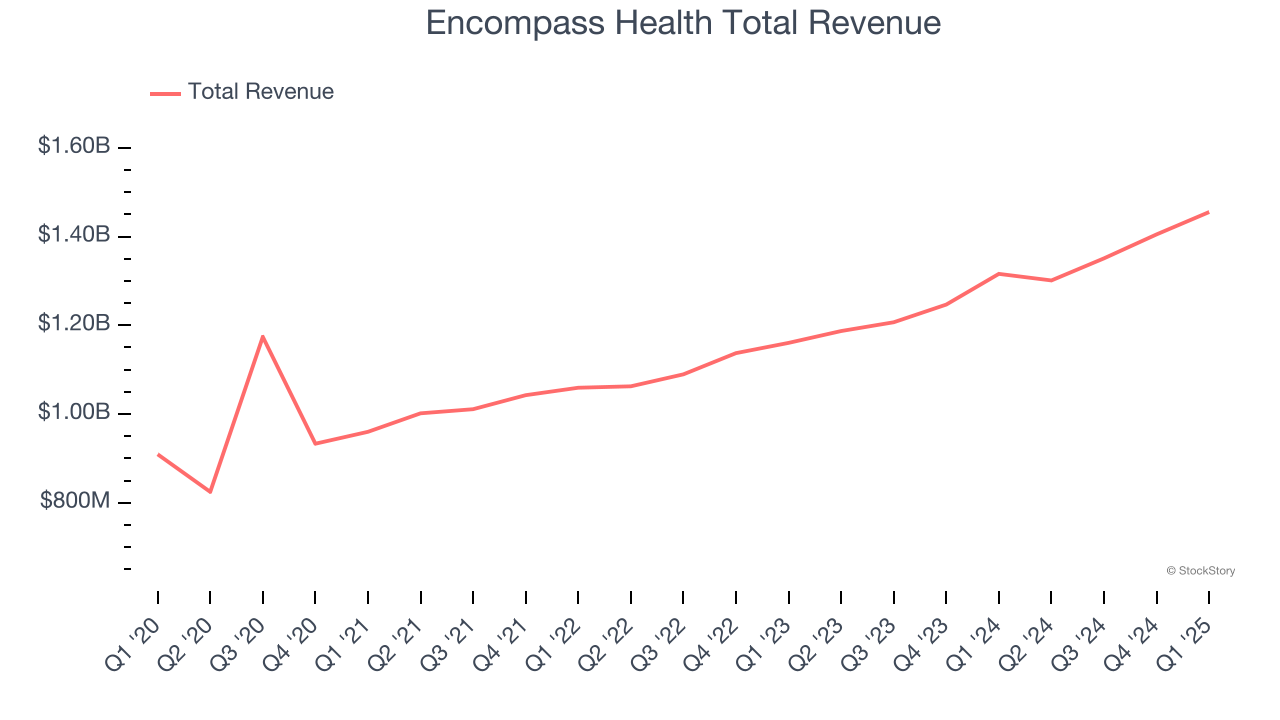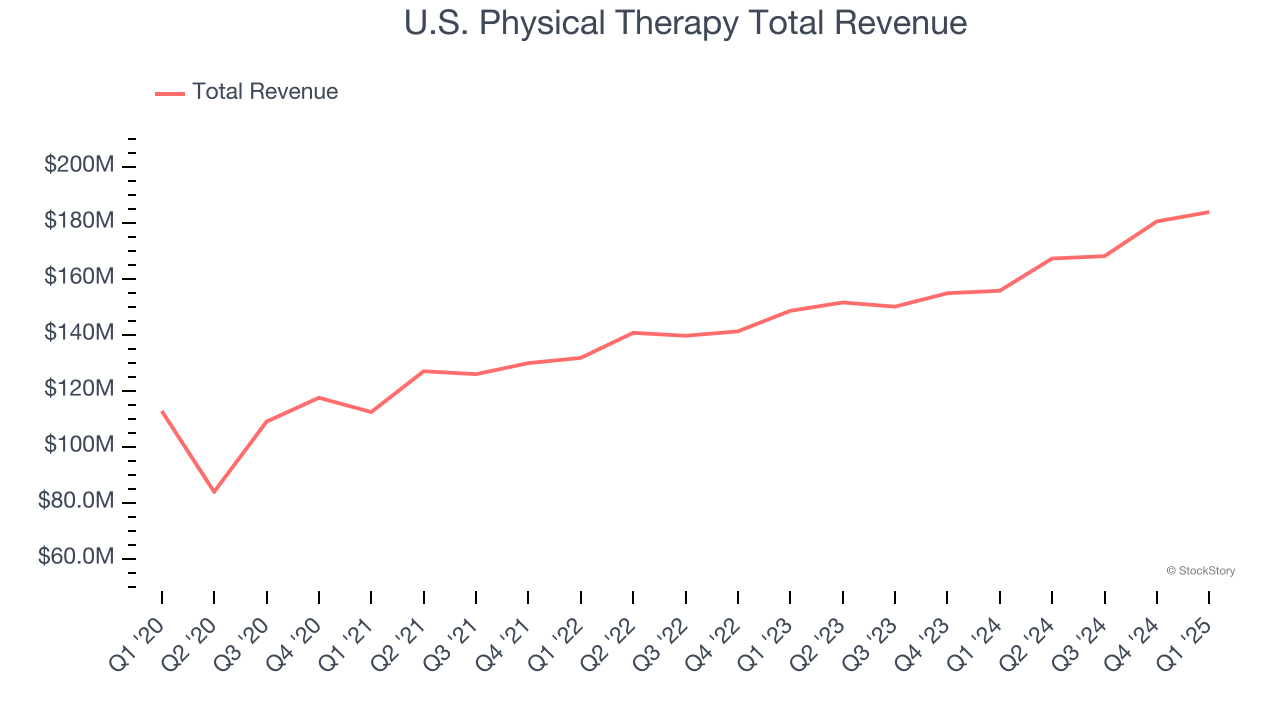
Earnings results often indicate what direction a company will take in the months ahead. With Q1 behind us, let’s have a look at Encompass Health (NYSE: EHC) and its peers.
The outpatient and specialty care industry delivers targeted medical services in non-hospital settings that are often cost-effective compared to inpatient alternatives. This means that they are more desired as rising healthcare costs and ways to combat them become more and more top-of-mind. Outpatient and specialty care providers boast revenue streams that are stable due to the recurring nature of treatment for chronic conditions and long-term patient relationships. However, their reliance on government reimbursement programs like Medicare means stroke-of-the-pen risk. Additionally, scaling a network of facilities can be capital-intensive with uneven return profiles amid competition from integrated healthcare systems. Looking ahead, the industry is positioned to grow as demand for outpatient services expands, driven by aging populations, a rising prevalence of chronic diseases, and a shift toward value-based care models. Tailwinds include advancements in medical technology that support more complex procedures in outpatient settings and the increasing focus on preventive care, which can be aided by data and AI. However, headwinds such as reimbursement rate cuts, labor shortages, and the financial strain of digitization may temper growth.
The 7 outpatient & specialty care stocks we track reported a mixed Q1. As a group, revenues beat analysts’ consensus estimates by 0.7% while next quarter’s revenue guidance was 0.6% below.
Amidst this news, share prices of the companies have had a rough stretch. On average, they are down 15% since the latest earnings results.
Encompass Health (NYSE: EHC)
With a network of 161 specialized facilities across 37 states and Puerto Rico, Encompass Health (NYSE: EHC) operates inpatient rehabilitation hospitals that help patients recover from strokes, hip fractures, and other debilitating conditions.
Encompass Health reported revenues of $1.46 billion, up 10.6% year on year. This print exceeded analysts’ expectations by 1.7%. Overall, it was a strong quarter for the company with an impressive beat of analysts’ full-year EPS guidance estimates and a solid beat of analysts’ EPS estimates.
"We are very pleased with our first quarter performance, which drove a 10.6% increase in revenue and a 14.9% increase in Adjusted EBITDA," said President and Chief Executive Officer of Encompass Health Mark Tarr.

Encompass Health achieved the highest full-year guidance raise of the whole group. Unsurprisingly, the stock is up 6.1% since reporting and currently trades at $107.67.
Is now the time to buy Encompass Health? Access our full analysis of the earnings results here, it’s free.
Best Q1: U.S. Physical Therapy (NYSE: USPH)
With a nationwide footprint spanning 671 clinics across 42 states, U.S. Physical Therapy (NYSE: USPH) operates a network of outpatient physical therapy clinics and provides industrial injury prevention services to employers across the United States.
U.S. Physical Therapy reported revenues of $183.8 million, up 18.1% year on year, outperforming analysts’ expectations by 4.4%. The business had an exceptional quarter with a solid beat of analysts’ sales volume estimates and a decent beat of analysts’ EPS estimates.

U.S. Physical Therapy pulled off the biggest analyst estimates beat and fastest revenue growth among its peers. The market seems content with the results as the stock is up 4.8% since reporting. It currently trades at $74.25.
Is now the time to buy U.S. Physical Therapy? Access our full analysis of the earnings results here, it’s free.
Weakest Q1: Select Medical (NYSE: SEM)
With a nationwide network spanning 46 states and over 2,700 healthcare facilities, Select Medical (NYSE: SEM) operates critical illness recovery hospitals, rehabilitation hospitals, outpatient rehabilitation clinics, and occupational health centers across the United States.
Select Medical reported revenues of $1.35 billion, up 2.4% year on year, falling short of analysts’ expectations by 2.6%. It was a softer quarter as it posted a significant miss of analysts’ EPS estimates and full-year revenue guidance missing analysts’ expectations.
Select Medical delivered the weakest performance against analyst estimates and weakest full-year guidance update in the group. As expected, the stock is down 21.6% since the results and currently trades at $14.29.
Read our full analysis of Select Medical’s results here.
DaVita (NYSE: DVA)
With over 2,600 dialysis centers across the United States and a presence in 13 countries, DaVita (NYSE: DVA) operates a network of dialysis centers providing treatment and care for patients with chronic kidney disease and end-stage kidney disease.
DaVita reported revenues of $3.22 billion, up 5% year on year. This number beat analysts’ expectations by 0.5%. Zooming out, it was a slower quarter as it recorded a significant miss of analysts’ full-year EPS guidance estimates and a slight miss of analysts’ sales volume estimates.
The stock is flat since reporting and currently trades at $145.17.
Read our full, actionable report on DaVita here, it’s free.
LifeStance Health Group (NASDAQ: LFST)
With over 6,600 licensed mental health professionals treating more than 880,000 patients annually, LifeStance Health (NASDAQ: LFST) provides outpatient mental health services through a network of clinicians offering psychiatric evaluations, psychological testing, and therapy across 33 states.
LifeStance Health Group reported revenues of $333 million, up 10.8% year on year. This print was in line with analysts’ expectations. More broadly, it was a mixed quarter as it also logged a solid beat of analysts’ EPS estimates but EBITDA guidance for next quarter missing analysts’ expectations significantly.
The stock is down 37.3% since reporting and currently trades at $4.11.
Read our full, actionable report on LifeStance Health Group here, it’s free.
Market Update
The Fed’s interest rate hikes throughout 2022 and 2023 have successfully cooled post-pandemic inflation, bringing it closer to the 2% target. Inflationary pressures have eased without tipping the economy into a recession, suggesting a soft landing. This stability, paired with recent rate cuts (0.5% in September 2024 and 0.25% in November 2024), fueled a strong year for the stock market in 2024. The markets surged further after Donald Trump’s presidential victory in November, with major indices reaching record highs in the days following the election. Still, questions remain about the direction of economic policy, as potential tariffs and corporate tax changes add uncertainty for 2025.
Want to invest in winners with rock-solid fundamentals? Check out our Top 6 Stocks and add them to your watchlist. These companies are poised for growth regardless of the political or macroeconomic climate.
StockStory is growing and hiring equity analyst and marketing roles. Are you a 0 to 1 builder passionate about the markets and AI? See the open roles here.






